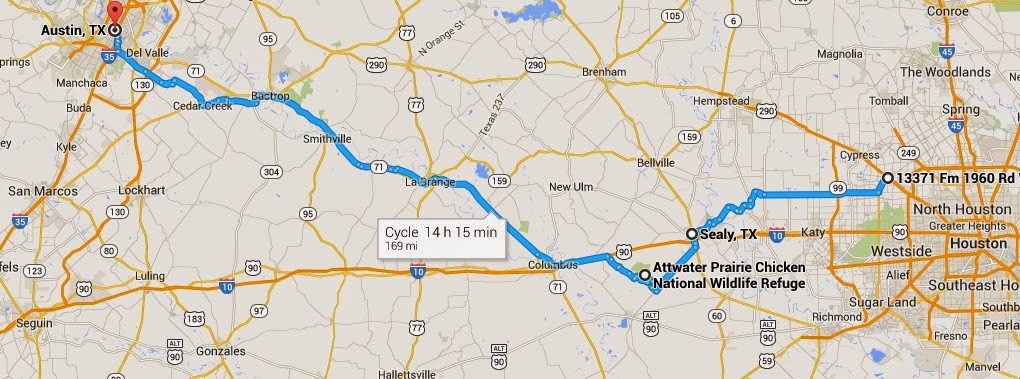The original plan for today was to ride out of High Island (TX) and make ground towards and around Houston. This is not what happened. As soon as I got out of bed this morning, I was completely crippled by indecision. This stemmed from two sources. First, the weather and wind forecast for the next few days is all over the place. There looks like there could be some really severe weather north of Houston on Sunday/Monday. If and how this would affect me is not 100% clear yet. Second, I just do not know what to do about the Attwater's/Greater prairie chicken. On one hand, I have the to time to try for this ABA countable bird. This will be by far my best shot at this bird this year. One the other hand it will take a lot of coordination, and although the birds are technically ABA countable, this population is only in existence because of continual human maintenance (kind of like of Whooping cranes in Florida). I do not yet know what the access situation will be, and I would also have to do a lot of riding through and around Houston which stands directly in my way.
A possible bike route around Houston
A better route I cannot take since it requires a ferry.
This route would better avoid Houston

Since I was endlessly waffling about what to do about the prairie chicken, I quickly decided to spend another night here on High Island to end my deliberation. In effect, I took a page out of the US government handbook and kicked the proverbial can down the road a day. I rationalized this decision on the basis that I would rather visit the Attwater's refuge on a clear Tuesday than a stormy Monday (its a 2 day ride from here) should I elect this route. This plan would also give me additional time to assess what help I might get from the folks at the refuge. Recall they will tell me on Monday what the access situation will look like. Thus, if I reschedule my potential visit for Tuesday, I will have all the information in hand upon my hypothetical arrival. The wind will actually aid me more tomorrow than it did today, so my decision made sense from this standpoint as well. I am sorry if this makes no sense, I am just trying to sort through it all in my own head.
Once I put my Attwater's decision on hold, I could get back to more immediate birding. I knew the strong south winds would make land birding around here terrible, so I decided to do some shore birding this morning. This turned out to be a great decision. My shorebird list for the morning was outstanding - 24 species in just a few hours at just 2 spots.
Black-bellied plover
Killdeer
Semipalmated plover
Piping plover
Snowy plover
Wilson's plover
American oystercatcher
American avocet
Black-necked stilt
Willet
Lesser yellowlegs
Spotted sandpiper
Whimbrel
Marbled godwit
Ruddy turnstone
Red knot
Sanderling
Dunlin
Semipalmated sandpiper
WHITE-RUMPED SANDPIPER- #332!
Least sandpiper
Long-billed dowitcher
Stilt sandpiper
Wilson's phalarope
The highlight of the day was my first White-rumped sandpiper of the year for bird #332. Finding this bird means that I have found all the central and eastern shorebirds that I needed to find during this leg of the trip. This is a nice weight off of me as I do not have to stop to scan every wet farm field I pass tomorrow. Finding this bird today means I can actually ride farther tomorrow.
***ALL FROM MY COLLECTION, NOT TAKEN TODAY!***
***Click thumbs for bigger images***
White-rumped sandpiper - note long wings
Head shot
Gotta love f/5.6 for the thin plane of focus!

I spent the afternoon kicking around the woodland areas on an incredibly quiet High Island. I found only 6 warbler species, the most notable of which was Bay-breasted. In hindsight, I should not have rebooked my room. I should have done the morning shore birding and then headed to the Best Western in Dayton, 60 miles to the northeast. Had I done this, I would be that much closer to where I ultimately need to be. I could then ride 2 short days (Sun, Mon) to reach the Attwater's NWR for Tuesday morning should I elect to do this. This bout of indecision is very uncharacteristic and a bit disturbing. Maybe it means I am starting to experience some amount of mental fatigue. For the first time in a while today, I started to wonder if I have might have tackled too large a task. Given I have been at this for 116 days now, I guess this is not altogether surprising; Its just a bit frustrating when it does. I was hoping that these days of light riding would really get me ready to attack the trans-Texas portion of the journey. Today I felt that I am in no way ready for this. I think today was a bit of a temporary wobble, so hopefully I will be able to properly motivate tomorrow to finally head out of here. The shorebird viewing did required a 20-mile ride, so at least I got my legs going a bit today.
For unbirders and birders who have not yet visited High Island, I will tell you it is a very popular destination at this time of year. Here is a shot of the viewing bleachers that have been placed near the bird bathing area. Dozens of folks hang out here as they wait for migrants to come and go from the bath. It's quite the social spot!
The players club! Hotter than
Studio 54 ever was.......sort of.





















































